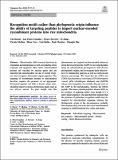Por favor, use este identificador para citar o enlazar a este item:
http://hdl.handle.net/10261/343906COMPARTIR / EXPORTAR:
 SHARE SHARE
 CORE
BASE CORE
BASE
|
|
| Visualizar otros formatos: MARC | Dublin Core | RDF | ORE | MODS | METS | DIDL | DATACITE | |

| Título: | Recognition motifs rather than phylogenetic origin influence the ability of targeting peptides to import nuclear-encoded recombinant proteins into rice mitochondria |
Autor: | Baysal, Can; Pérez-González, Ana; Eseverri, Álvaro; Jiang, Xi; Medina, Vicente; Caro, Elena CSIC ORCID; Rubio, Luis M.; Christou, Paul; Zhu, Changfu | Palabras clave: | Green fluorescent protein Mitochondrial pre-sequence Mitochondrial protein Protein sorting Subcellular targeting |
Fecha de publicación: | 1-feb-2020 | Editor: | Springer | Citación: | Transgenic Research 29(1): 37-52 (2020) | Resumen: | Mitochondria fulfil essential functions in respiration and metabolism as well as regulating stress responses and apoptosis. Most native mitochondrial proteins are encoded by nuclear genes and are imported into mitochondria via one of several receptors that recognize N-terminal signal peptides. The targeting of recombinant proteins to mitochondria therefore requires the presence of an appropriate N-terminal peptide, but little is known about mitochondrial import in monocotyledonous plants such as rice (Oryza sativa). To gain insight into this phenomenon, we targeted nuclear-encoded enhanced green fluorescent protein (eGFP) to rice mitochondria using six mitochondrial pre-sequences with diverse phylogenetic origins, and investigated their effectiveness by immunoblot analysis as well as confocal and electron microscopy. We found that the ATPA and COX4 (Saccharomyces cerevisiae), SU9 (Neurospora crassa), pFA (Arabidopsis thaliana) and OsSCSb (Oryza sativa) peptides successfully directed most of the eGFP to the mitochondria, whereas the MTS2 peptide (Nicotiana plumbaginifolia) showed little or no evidence of targeting ability even though it is a native plant sequence. Our data therefore indicate that the presence of particular recognition motifs may be required for mitochondrial targeting, whereas the phylogenetic origin of the pre-sequences probably does not play a key role in the success of mitochondrial targeting in dedifferentiated rice callus and plants. | Descripción: | 16 Pág. | Versión del editor: | https://doi.org/10.1007/s11248-019-00176-9 | URI: | http://hdl.handle.net/10261/343906 | DOI: | 10.1007/s11248-019-00176-9 | ISSN: | 0962-8819 | E-ISSN: | 1573-9368 |
| Aparece en las colecciones: | (INIA) Artículos |
Ficheros en este ítem:
| Fichero | Descripción | Tamaño | Formato | |
|---|---|---|---|---|
| Recognition_motifs_rather_than.pdf | artículo | 1,91 MB | Adobe PDF |  Visualizar/Abrir |
CORE Recommender
PubMed Central
Citations
5
checked on 30-abr-2024
SCOPUSTM
Citations
5
checked on 28-abr-2024
WEB OF SCIENCETM
Citations
6
checked on 26-feb-2024
Page view(s)
9
checked on 30-abr-2024
Download(s)
3
checked on 30-abr-2024

